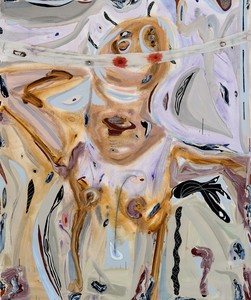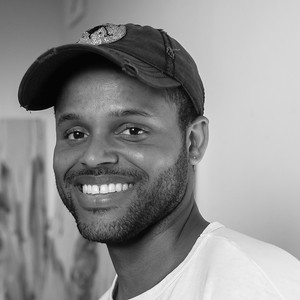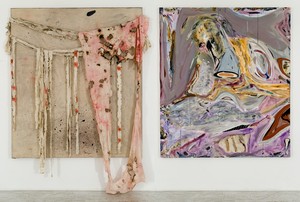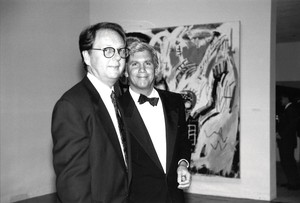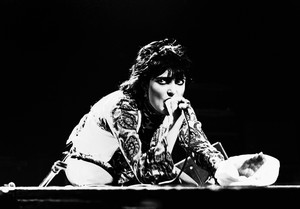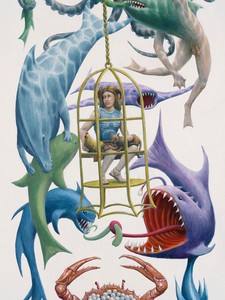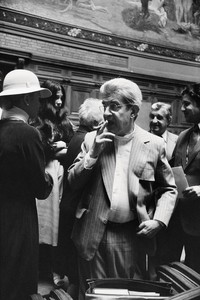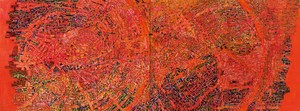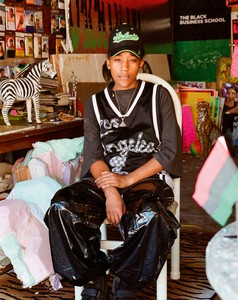In the last few years, the phrases “I can’t breathe” and “Nou bouke” (Creole for “We are tired”) have been used by African Americans and Haitians to express frustration, fatigue, and anger over our ongoing struggles for equality and the right to live safely with dignity. These sayings inspired different ideas in me about the politics of power, about how these politics can bend reality. I am not interested in academically theorizing this issue, but it does come to mind that inside the belly of any power dynamic there is a pushing and pulling, a sort of dance of resistance.
My work usually presents certain concepts dancing with their contradictions. Whether in one painting, a group of paintings, or an entire show, I came to understand this as part of the internal dynamic of my work because that’s the only way I know how to create a world of infinite possibilities for myself. This is what I call getting us to the other side of the mirror. My paintings Siblings (2021), for instance, were realized some time ago, before this deeper interest around power became more important to me, but somehow the two are still linked, since Siblings plays an important part in that dance of resistance.
My sensibility helps me to connect and define myself through art. One image that always comes back to me is Goya’s painting of Saturn eating his son. I first saw it when I was fifteen years old, and my early mentor in Haiti introduced it to me. I still use that painting as a trampoline to bounce off, even for certain ideas in some of my works in this show at the gallery.
This dance of resistance also relates to my feelings about belonging and what belonging means to me. I feel I belong to Haiti, but not necessarily to the land, the atmosphere, or the food. What makes me feel I belong is the connection with the people. I find myself exactly fitting a particular shape in their hearts, and vice versa. Regardless of the challenges that we face as people, the sense of the sisterhood and brotherhood of the Haitian people is so strong that it can ignite a revolution, a profound shift of paradigm. My experience of brotherhood and sisterhood resides in my capacity to deeply see myself in the other. This capacity implies that the other will never hit the ground when they fall, because someone close enough will always be there to catch them before they crash. That’s how I understand a sense of unity and what it means to be whole.
You might have heard of the recent killing of Jovenel Moïse, the former president of Haiti, or of the even more recent earthquake there. These are very afflicting realities that if you are Haitian you carry like a bag of stones. Even if you follow the news, you might have missed the killings and massacres that happened during the several weeks before the president’s assassination. I am not mentioning this to ask for a certain response; these are just facts that I need you to be aware of to get my point.
Haiti’s brother- and sisterhood is altered by the need to survive profound challenges from both politics and acts of God. The deepest cut for me is the incapacity to project yourself into the future because every day your hope for a better life and for dignity is questioned and shaken, sometimes by your own people. This underlines that it’s not only a matter of Black or white, since unfortunately we are all ultimately facing the same demons. This situation intensifies the present in a way that can be detrimental, especially since that present is existentially complex.
The process of creating an object that has a spiritual value is the only thing that intensifies my presence, and at the same time reminds me of my ephemerality. It is complex how power can shape the destiny of a nation and its people. Those massacres and abuses of power become part of my imagination. W.E.B. Du Bois famously suggested a double consciousness; I experience maybe even a triple or quadruple consciousness, because no matter where I land, my Blackness is never perceived as an unchangeable monolith.
Saturn, while eating his son, is presented in a position of overt strength, but what he is really trying to deal with is his fear and fragility. It was that same fear of losing power that led François Duvalier, president from 1957 to 1971, to arm the Tonton Macoute, an unhappy and desperate category of people, at a pivotal moment in my country’s racial history. What can explain someone becoming completely oblivious to the value of life? From a more global point of view, Duvalier would never have had the capacity to do so if his instruments of power hadn‘t been fueled by the ascension of the economic system that we are all part of today. As with many dictatorships at the time, Duvalier’s power was collateral damage of the Cold War. Is it enough to say today that history repeats itself, or is it time to admit that we simply never learn?
These moments, challenges, and realizations are at the core of how I understand my place in the world. Exploring the complexity of my own subconscious as a Haitian and a Black person in this world is the work of a lifetime. Deciding to bring that subconscious into the immaculate space of the white cube, a space that is arguably not yet fully adapted for it, is my ambivalent but purposeful way to create room for it and preserve it in the light.
In that same journey of putting forward the sacred burden tied to my existence, I decided with Portal (2021) to make a work whose only relevance resides in the spiritual value that I myself find in it. By creating what I think of as a “false” mythology, I call on the viewer’s understanding to consider that the positioning of the objects refers to something that we have in common and that viewers can take away with them. Understanding that I can create a spiritual value through my actions undeniably forces society to acknowledge my humanity, especially considering that humanity was denied to me by many people for centuries. Accepting this today occupies a space in the viewer that initiates a social awareness. This seems banal and obvious, but it’s important. The spiritual contribution and the sacred connection we Black people have and make to the world isn’t something that comes from the conscious or subconscious of white people or anyone else. No matter how small and personal the new form of awareness I am trying to reveal is, it is to me fundamentally there to remind us that we are all dancing to the same drums.

